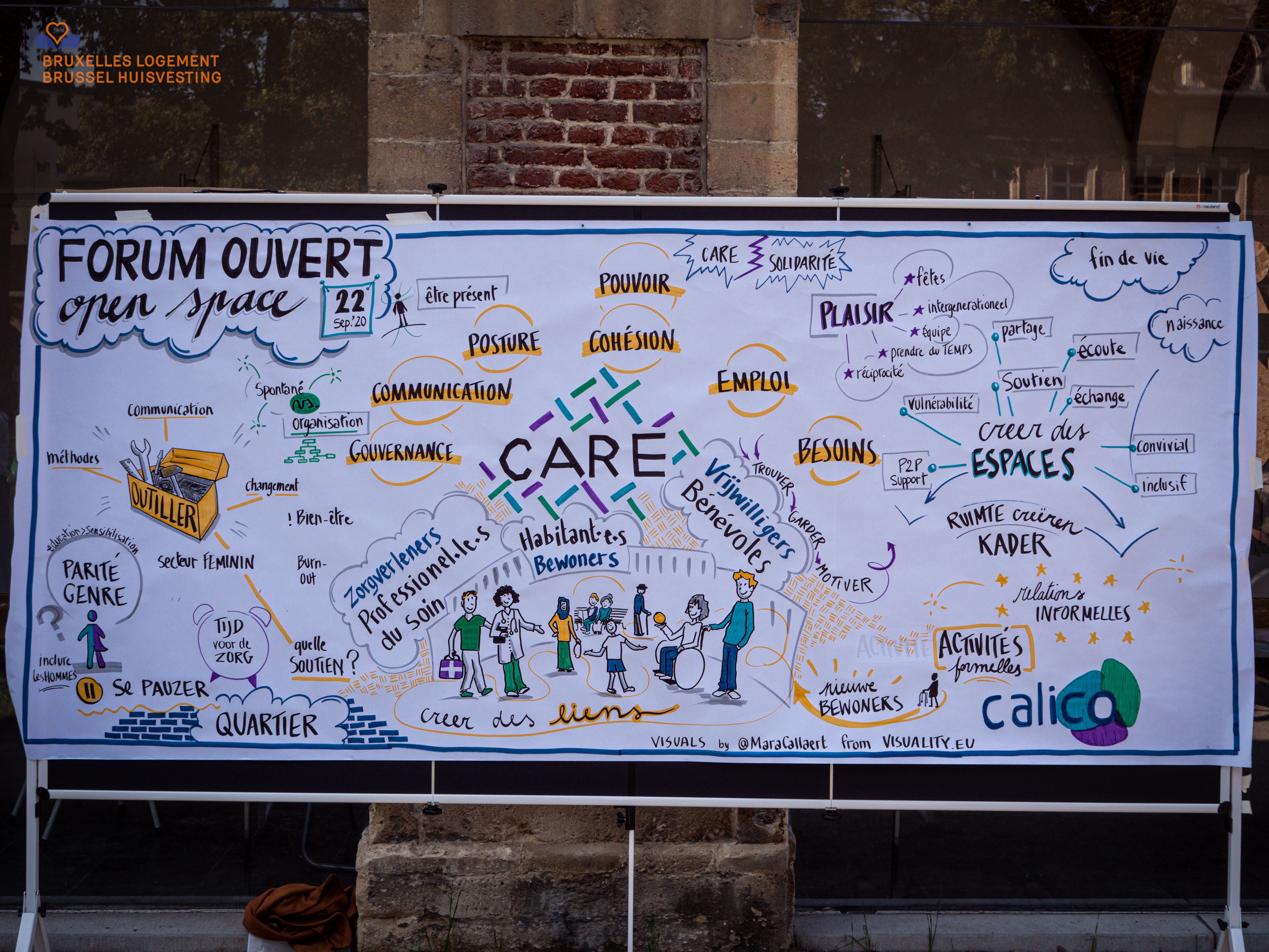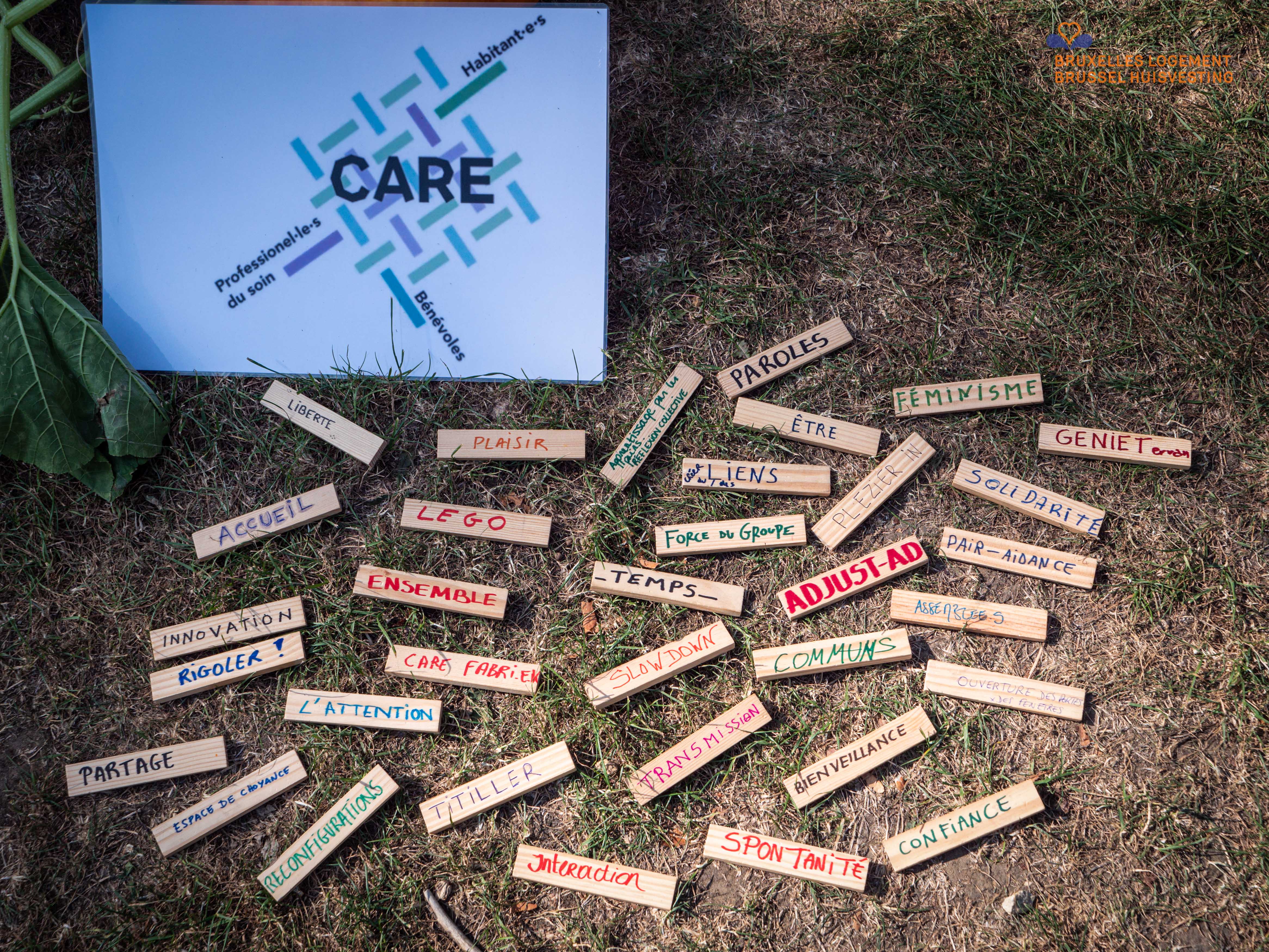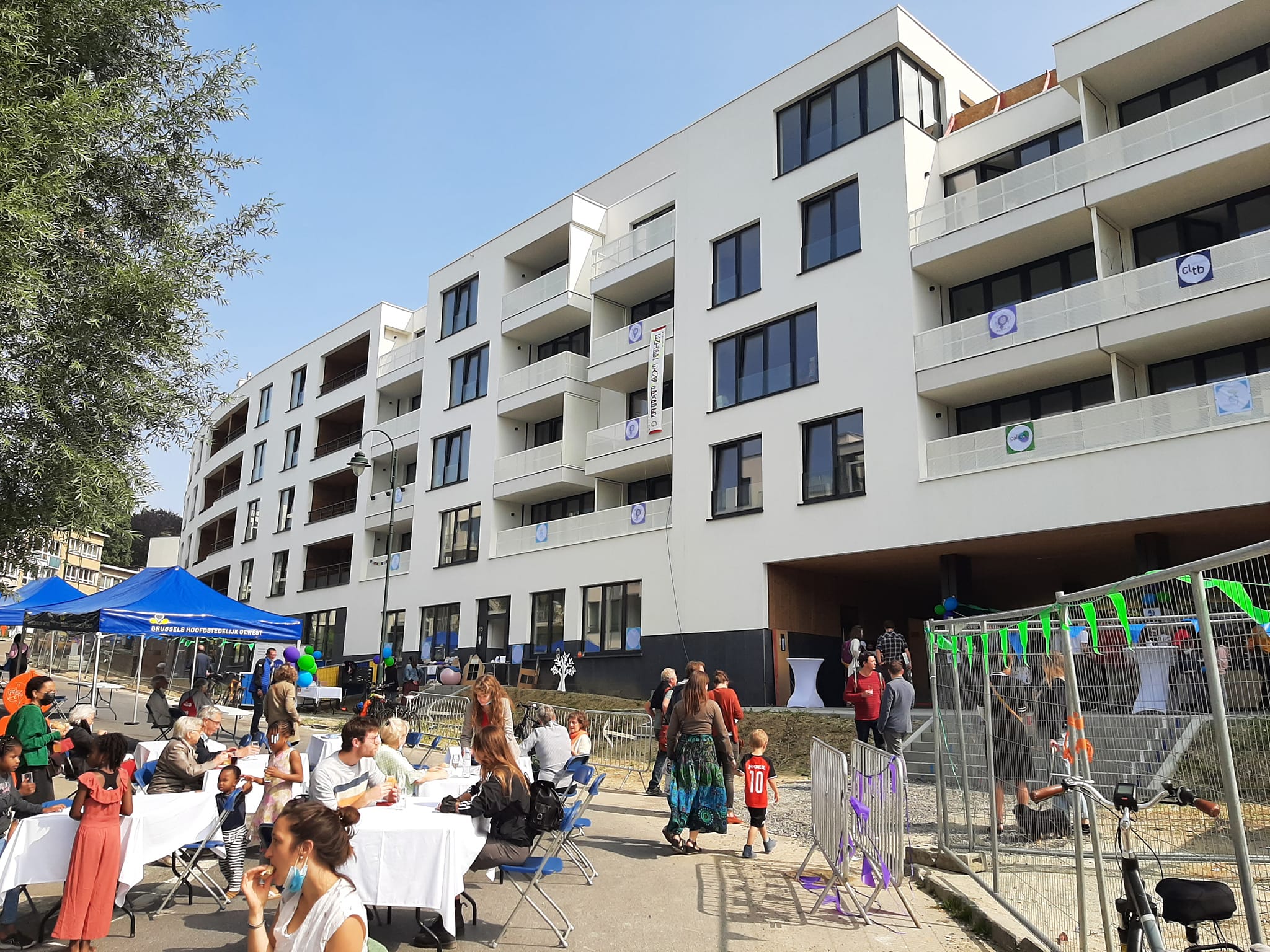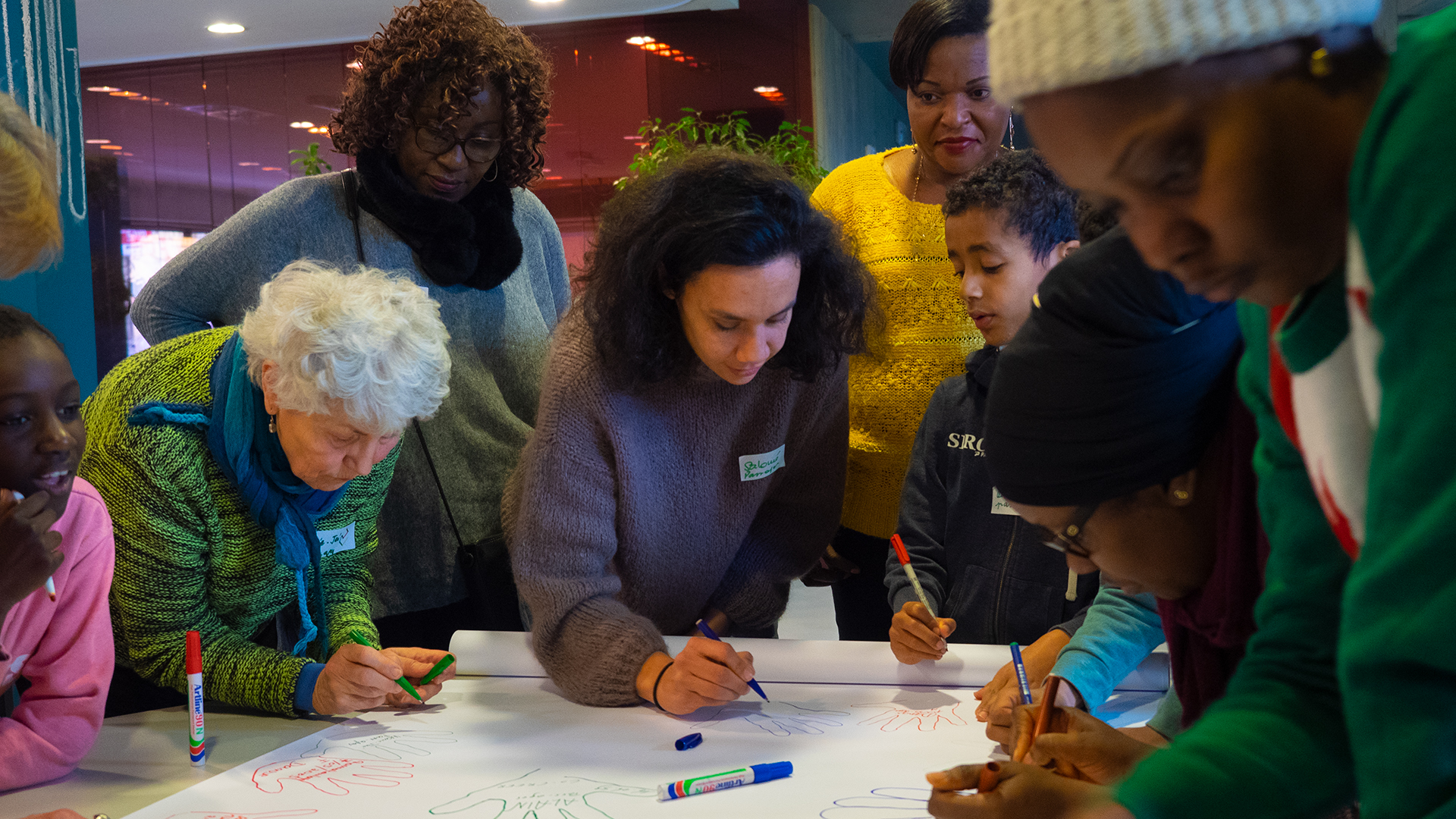CALICO is a cohousing project of 34 dwellings offering a generational and social mix in interaction with the neighborhood. Its priorities are gender equality, welcoming birth and end-of-life facilities at the heart of living together, an innovative community-base model of care, and access to housing within the framework of a Community Land Trust, i.e. a plot of land managed as a common good.
Urban Innovative Actions, 2018.
CALICO is a cohousing project of 34 dwellings offering a generational and social mix and is developed within the common and anti-speculative framework of a “Community Land Trust”. It also integrates an innovative community-based model of care. It is the result of a collaboration between different housing actors, local and regional authorities, and academic partners. The housing project is organized in 3 clusters:
- The “gender” cluster rents dwellings to older women and single mothers. Subsequently, the initiators and residents of this cluster are responsible for putting gender issues at the center of our housing project through awareness-raising and training activities on gender equality issues;
- The "Community Land Trust" cluster sells dwellings to low-income families and rents to older people (+55yo) unable to obtain mortgages. They also provide two housing units dedicated to Housing First for homeless people ; On top of managing one housing cluster, the CLT owns the land of the whole housing project, thus guaranteeing its permanent affordability;
- The "care" cluster not only offers intergenerational cooperative dwellings, but also a birth and end-of-life facility, integrated within the housing clusters, that provides adequate spaces for people wishing to give birth or die in an empathetic and familiar environment. This cluster’s purpose is to create a benevolent living space in Brussels, open to its environment, designed to welcome anyone who wishes to live these «life passages» naturally, in harmony and in connection with others, accompanied by professionals and volunteers.
Furthermore, one common space is open to residents and one is managed as a meeting place for people with mental health issues and where local initiatives are held, therefore CALICO will be a full-fledged player in the local urban fabric.
The multi-committee governance scheme of the project aims at empowering the residents by putting them at the heart of the decision-making.
Please highlight how the project can be exemplary in this context
- Land Stewardship as guiding principle: One of the key ideas behind this project is the fact that it considers land as a common good. By separating ownership of the land from the ownership of the building, and by managing that land as a commons, the CLT model guarantees permanent affordability. The multi stakeholder governance model also guarantees the continued alignment of the use of land with the needs of future generations.
- Passive building and training: As of 2015, Brussels became the first region in the world to require the passive house standard for all new construction, thus contributing to a sharp decline in carbon emissions. However, studies have shown that very often, especially in social housing context, much of the energy gain is lost by an incorrect use of the building. That's why we organised several specific training sessions and tools to help the residents use their passive house technology in the most optimal way.
- Sharing as a way of life: the cohousing approach makes sharing easier. Residents started collecting food waste for organising a weekly community kitchen, and there are plans to set up an organised sharing scheme among residents.
- Sustainable mobility: Bicycle lessons have been set up by CLTB residents in order to teach other, mainly migrant women,) how to ride a bike.
- Community garden: the residents will be in charge of managing the community garden at the heart of the housing project
- Workshops ecological painting: As explained further on, due to the very sharp timeline of the EU Urban Innovative Action call that financed the project, we were constrained to buy a housing development that already received a building permit, and so it was not possible to have major influence on the building techniques. We could only decide over the finishing techniques, for example workshops ecological painting were organised with the residents.
Please highlight how the project can be exemplary in this context
Community Land Trust Brussels developed an exemplary approach towards involving future residents in the design of its housing projects. In the case of the CALICO project, it was impossible to apply this methodology, as the Urban Innovative Action program required the projects to be delivered within three years. In order to deliver a housing project within this short deadline, we looked for a project in development, that met enough requirements to turn it into the project we dreamed of, within the public procurement rules. After an intensive market exploration, analyses and evaluation, we selected the "Les Sources" project. The project is part of a larger housing development in the municipality of Forest and represents a high-quality residential building. The most interesting features to turn it into a vibrant cohousing project were the large semi-public porch at the center, leading to a community garden and creating access to one of the community spaces on the ground floor. Both the porch and the garden act as meeting places for the broader community.
Once we selected the building, we organised co-creation workshops with future residents to adapt the existing project as much as possible to the needs of their cohousing project. As a result, we were able to transform two apartments into meeting spaces (one reserved for the CALICO residents, another one managed as a meeting place for people with mental health issues and activities open to the wider community), and two other apartments into the birth and end-of-life facilities. Although the project would probably have been very different if residents could have been involved in the design process beforehand, the result meets the needs of the community and is an example of how a classical housing project can be transformed into a well-functioning cohousing project.
Please highlight how the project can be exemplary in this context
Since the beginning of the project, all three housing clusters have applied the co-design and participation system already used by the Community Land Trust Brussels. This implies co-design and participation with the (future) residents from day one with the objective of empowering them and involving them in the decision-making process. Throughout the project, attention was also paid to the wider public participation and their ideas, needs, concerns regarding the development of CALICO
One of our main objectives is providing affordable and qualitative housing through the CLT-model, i.e. by separating the ownership of the land from the ownership of the housing built on it, as well as an anti-speculative resale formula.
Adjoining this, specific measures have been taken to ensure an intergenerational and social mix of the residents, as well as to provide housing for (older) women and single parent-families. Due to the unequal access to affordable quality housing, CALICO focuses on three vulnerable groups in particular: older people, (single) women and people with a migration background. These people face particular difficulties in finding affordable and quality housing due to their socio-economic and health background. Two homes are devoted to Housing First for the homeless.
CALICO also wants to contribute to care and wellbeing through the development of a ‘Community Care Model’. In response to the hyper-specialized and -sectorialised care in Belgium, CALICO joins a more general movement of ‘socialization’ of care, where care for people with health problems or disabilities is organised more within the neighborhood (instead of within institutions), but also by (members of) the neighborhood. The project puts community back at the center of the process of care of the different life stages, being birth, older age and end of life. As a result, specific attention is also to ‘age in place’, although the home environment in Brussels often do not meet their needs.
Please highlight how this approach can be exemplary
Within the context of an existing housing development, the project is exemplary in the field of:
- a non-speculative approach to ownership: Not only is the project developed on community land, using the community land trust model, two housing cooperatives have been created to hold part of the building. Never before in Brussels both non-speculative tenure models have been combined;
- social inclusion of migrants, older adults, vulnerable women and the homeless: There is a strong intergenerational and cultural mix, with a strong representation of the most vulnerable groups, those who are the most excluded from appropriate and affordable housing in the city;
- community care: We developed an adapted community care model, based on solidarity between residents. The innovative Birth and End-of-life facilities as well as the meeting space for people with mental health issues are part of this model, but also have a regional dimension.
- Fight gender inequality by putting the gender dimension at the heart of a housing project;
- Develop a community led governance model: Care and Governance groups, as well as different workshops, will guarantee a continuous management of CALICO objectives. Residents are trained in governing and management techniques, to enable them to manage the buildings and sustain a vibrant community.
- Building a resilient community, by providing shared spaces and promoting a sustainable lifestyle among vulnerable groups.
Through all these dimensions, the project aims to setting the example for a new approach to urban development and housing. By closely involving local and regional authorities and academic partners, the project aims to develop new ways of living together and new opportunities for project development, in order to learn lessons and apply them in regional policy.
The results of the project are numerous and were monitored by setting up a research design using a mixed-method approach, including both quantitative and qualitative methods. First of all, CALICO provides stable, affordable housing in a caring environment to 34 households, 2/3 of which are low-income. Inclusive and diverse, the project has targeted specific needs of older adults, of single women and mothers, and of homeless people. The project is intergenerational (50% of the inhabitants are over 50) and multicultural (50% of the inhabitants have a migration background).
Gender approach and Care are at the heart of the design of the cohousing project. Most inhabitants access the project via a commitment to a feminist perspective and/or a voluntary commitment to care structures integrated into the housing. These original allocation procedures open new perspectives for the definition of empowering public housing policy based on the support of community intentions. Furthermore, the care dimension is realized by the integration of a birth and end-of-Life facility managed by the inhabitants as well as by the realization of a common space between inhabitants and the neighbourhood. Also, 78,8% of the residents consider that they have had the opportunity to establish a relationship of mutual support and solidarity with one or more CALICO participants.
Participation, citizen engagement and co-designing the project were key. Numerous meetings were held to organise this complex governance of the project: around 165 meetings between partners, around 100 at cluster level and 32 between all the inhabitants took place. The participation rate of the inhabitants in the meetings involving them was very high (around 75% on average), especially given the pandemic situation. 87,9% of the residents have declared that they have felt that their views have been considered in setting up the project.
Please also explain the benefits that derived from their involvement.
CALICO started as a bottom-up project. It builds on a citizens action in which Brussels activists and actors from civil society explored new ways of urban development and of building affordable housing, based on the principles of the Commons.
These partners (including NGOs and cohousing groups) reached out to the Regional authority as well as to academic partners to co-develop a project within the EU UIA-call. They involved other associations and community groups from the surrounding community in the project development. For example, during thematical "strategic committees" a wide range of peer organisations and experts were involved in co-construction of the care, gender and governance dimension of the project. In order to gain insights on the community level, also in-depth interviews were held with 39 residents living in the surrounding of the CALICO project.
From the start of the project, the initiators of the three housing clusters set up an allocation process of the homes to be able to involve future residents as soon as possible in the project design.
A long series of co-design and training workshops with the future residents has been set up, both within the own cluster as with the three clusters together. In these workshops, decisions about the use and management of shared spaces, a community charter, a governance structure, and a community care model have been designed. The residents will be in charge of managing the building and sustaining community life.
Over the course of the project, the initial partnership has been widened. CALICO entered a partnership with Rézone, a regional mental health network, who developed a “bonding space”, open space for anyone and conceived as a safe space for people with mental health issues. Furthermore, CALICO started working with local neighborhood committees, with organisations active in the field of soft mobility, community kitchens, and many more.
This approach will form the basis of a resilient community.
The main urban challenge we are faced with is a housing crisis that particularly affects vulnerable groups, such as low-income and/or single-parent families, migrants and (older) women. Brussels region has a shortage in social housing (long waiting lists), low quality housing in general (many dwellings lack basic facilities) and an increase in real estate prices and rent. Often, households spend over 60% of their income on housing.
A second challenge is the housing situation and the quality of life of specific vulnerable groups. The region confronted with an ageing population that increasingly needs support and often find themselves isolated. Seniors are motivated by policy to ‘‘age in place’’. Unfortunately, some home environments are unfavorable, because the “fit” or “liveability” does not match changing needs. Inadequate homes form a risk for the health, wellbeing, and the independence of older people.
Women, particularly older women, face a higher risk of social isolation and poverty because of their low pensions or income. And also people with migration background are heavily discriminated in the private housing market.
Low-income families experience several challenges in the housing market. They are more present in disadvantaged neighborhoods, tend to live in overcrowded housing, spend a high amount of their income on housing (at the cost of other expenses such as food, healthcare, education).
On top of that, these vulnerable groups are often excluded from decision-making processes within the public sphere, thus lacking the empowering potential of participation.
The final challenge is the need and strong focus on community care, which refers to a growing paradigm shift in which care for people in need becomes less institutionalised, and increasingly becomes the responsibility of civil society. The paradigm shift entails that care takes place within and by the community, as opposed to institutionalisation.
The innovation lies in the articulation of a mixed financing, governance scheme associating CLT, cooperatives, non-profits and residents, the legal framework for the CLT and the interaction with the neighborhood.
The innovation of the project lies mainly in the integrated approach it intends to implement. It aims to develop a new governance model for community-led housing. This new model should integrate issues of empowerment, social inclusion, gender equity, wellbeing and health care, intercultural dialogue, solidarity and community engagement, as well as sustainability issues by both guarantying a permanent affordability of the housing and collectively managing the land.
Though the CLT-model isn’t new, we’re providing an intergenerational mixture of owner-occupied and rental housing developed under innovative cooperative schemes.
In order to provide affordable and qualitative housing, not only the land, but also the collective spaces were purchased by the CLTBrussels, guaranteeing that the housing units stay permanently affordable.
The project also combines different forms of tenures. The units are made available on long-term leases to owner occupiers or rented mainly by vulnerable households. In the case of renting by households under the conditions of access to social housing, the rental management will be handled by the social rental estate agency (AIS) "Housing for all", partner of the project.
The rental units are owned and financed by an investment cooperative, but the care cluster housing units are owned by a cooperative that includes residents' shares in the financial scheme.
Beyond supervised access to decent housing, the project intends to support the emancipation of residents through participation processes and develop a real community care philosophy including services open to the wider neighborhood.
Incorporating birth and end-of-life facilities, and therefore encompassing the entire lifecycle, into a cohousing project is a world first.
Please provide clear documentation, communication of methodology and principles in this context.
Being funded by UIA, knowledge transfer, scaling-up and transferability are a requirement.
Project results are therefore shared at different levels (local, regional and international) and in different ways (research reports, popularising and practice-oriented articles, participating in conferences, website, etc). For the dissemination, we closely cooperate with an academic partner and we also rely on the existing networks of the project partners. A selection from documentation and communication actions to disseminate project results:
1. The monitoring and evaluation of the CALICO project is performed by researchers of the Vrije Universiteit Brussel (VUB). Four reports on project results (using a mixed-method study design) will be published:
- A first initiatory report (2019) provided the groundwork for the evaluation and monitoring of the CALICO-project;
- A second report published (2020) provided an intermediate evaluation;
- A third report (2022) provides results from the second and final evaluation;
- A fourth report entails final concluding remarks and evidence-based recommendations for policy and practice that touch upon various policy areas such as housing, community-led strategies, Community Care strategies, gender mainstreaming approaches, … and social cohesion.
2. Results, governance models and lessons learned are disseminated to other European cities and supra-local governments, by the various networks project partners are involved in. For example, dissemination will notably be supported by the SHICC EU partners to also reach their network. This is done, for example, through active participation in conferences (e.g. European Network on Housing Research), inclusion of CALICO in newsletters, contributions to new project proposals, and actively formulating proposals for new housing policies, etc.
The dissemination of these results will support the development of future initiatives in Europe and around the world.




@Brussels Capital Region, 2021
Content licensed to the European Union.